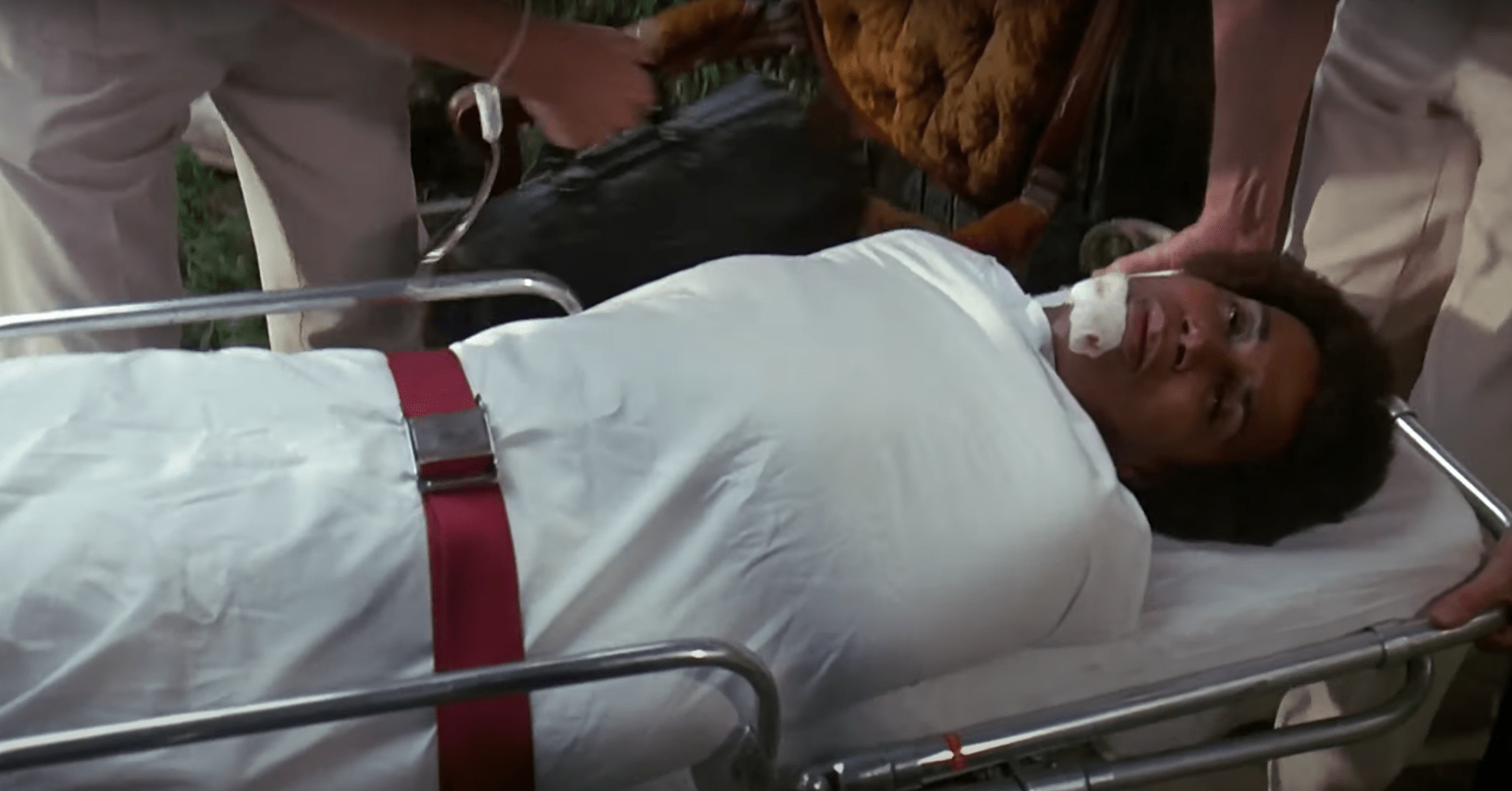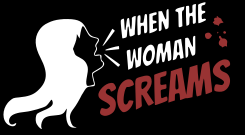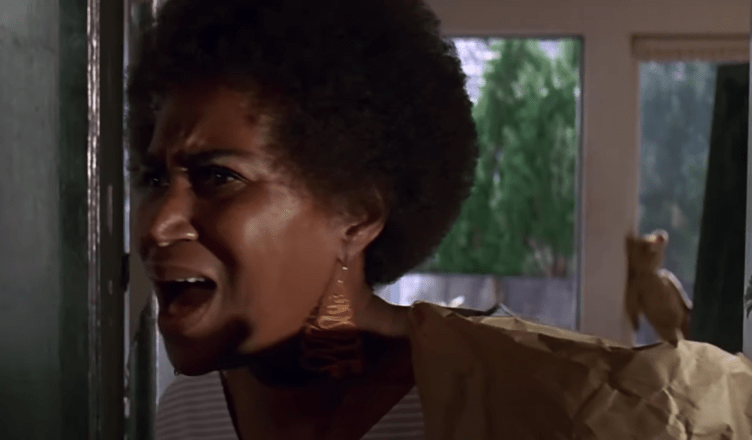Film Deets:
Director: Clint Eastwood
Screenplay: Jo Heims and Dean Riesner
Actresses: Clarice Taylor, Jessica Walter, Donna Mills
Category: Systemic White Supremacy
Themes: Racism, Mental Illness
Why do these screams matter?
A psychological thriller that follows the increasingly obsessive behavior of a woman besotted by a radio DJ, Clint Eastwood’s Play Misty for Me (1971) is typically recognized for creating the “scorned woman” template that would later be leveraged to great success in Fatal Attraction. In the film, Evelyn Draper (Jessica Walter) stalks and menaces Dave Garver (Eastwood), violence that culminates in Evelyn taking Garver’s on-again/off-again girlfriend, Tobie (Donna Mills), hostage. But it is the film’s dismissive treatment of its supporting character, Birdie (Clarice Taylor)–its positioning of Black women as expendable–that deserves consideration.
In this scream set, Birdie enters Dave’s home to find it ransacked. She is caught off-guard by Evelyn who, in a psychotic state, repeatedly stabs Birdie as Birdie screams for help.
As Dave’s housekeeper, Birdie occupies a space with a complicated cinematic history. In writing about the evolving depictions of maids in films, Linda K. Fuller argues, “Vacillating between gratuitous and back to incidental, the role of the maid as a stock character remained stymied, with no change from the 1960s” (115). This stagnancy is complicated by how films typically cast Black women in the roles of domestics. A 2019 study looking at the representations of Black women in Hollywood found “Black female characters are twice as likely as white female characters and other female characters of color to be shown in a service industry job (56.3% compared to 26.4% and 20.6%, respectively).” Indeed, Birdie is often forgotten in critical analysis of the film. When she is mentioned, it is typically by her profession (“cleaning woman” or “cleaning lady”) and not her name (see Knee 98; McGinley 594). And yet, Birdie’s treatment in the film is not uncommon and in fact, demonstrates how character archetypes can perpetuate racism by trading on tropes rooted in white supremacy.
Here, the violence perpetrated against Birdie evident in her screams is visceral and contrasts significantly with the violence deployed against Tobie, a white woman, later in the film. While we see Birdie’s body cut repeatedly as she attempts to get away from her attacker, the severity of which is suggested by numerous sprays of blood on the walls, Tobie remains physically unscathed with the exception of having her hair cut off by Evelyn. This radically oppositional treatment of the two women by Evelyn makes little sense narratively, particularly since Birdie does not pose a threat to Evelyn’s fantasy of a romantic relationship with Dave in the same way Tobie does. Referencing the work of bell hooks, Brittany Terry notes, “The role of the black woman in American society and film is to play the role of object in direct relation to white female existence” and that would seem to be born out in Play Misty for Me (5). Birdie’s physical body becomes an object upon which Evelyn’s brutality is mapped- a mapping that is conveyed via the intermingling of Birdie’s screams and pleas for help. With its casual depiction of the aftermath of her injuries, the film treats Birdie as wholly expendable while never positioning Tobie or even Evelyn in the same way.

It is not only the extent of the violence Birdie suffers that distinguishes her from the white women in the film, it is also the dialogue following the attack that perpetuates an “Othering” of Birdie. Having arrived at the crime scene, Dave finds Birdie on a stretcher about to be taken to the hospital. Rather than express horror at what Birdie has gone through, Dave is stoic and simply mutters her name quietly as he takes in the scene. While it might be argued that Dave is in shock, his failure to be outwardly horrified by what Birdie has endured reads as a dismissal of her trauma, especially when coupled with Birdie telling him it will cost double to clean up the mess. As Adam Knee recognizes in his examination of the dialectic of female power in the film, “Even as a victim, the cleaning woman is the subject of the film’s ridicule” (98). Certainly, it is not unheard of for horror films to disrupt narrative tension through humor as a way of keeping the audience unbalanced in their expectations and thus, more susceptible to jump scares. Critter’s Charlie, Scream’s Randy, Friday the 13th: The Final Chapter’s Jimmy, and Get Out’s Rod are all characters whose wry observations provide audiences space to decompress from an onslaught of dread. But in all those instances, humor is deployed throughout the entirety of the film. Here, the only moment of levity in the film is in relation to Birdie being violently stabbed. The tonal shift in humor only occurs in that scene and it trivializes what Birdie has endured and implies the violence is somehow less deserving of the audience’s sympathies.
Birdie’s treatment also reflects racist medical thinking, such as J. Marion Sims’ contention that Black women have a higher pain tolerance, in that she’s making jokes instead of expressing pain from her numerous wounds (Spettel & White 2426). This invites the audience to chuckle at Birdie’s joke rather than to see her fully as a victim. She becomes, as Fiona Mills writes, “The black domestic [who] had to be acquainted intimately with the dynamics of performance. She had to smile when she really wanted to slap someone” (xi). Birdie’s sarcastic observation nullifies the power of her screams by suggesting that the violence she sustained wasn’t all that bad–her brutal attack not that painful. After all, she can still crack jokes. And she can still come back to clean up the mess.
Works Cited
Fuller, Linda K. “From Servile to Sassy: A Look at Hollywood’s “Maids”.” Beyond the Stars: Stock Characters in American Popular Film, edited by Paul Loukides & Linda K. Fuller, Popular Press, 1990, pp. 110-119.
Knee, Adam. “The Dialectic of Female Power and Male Hysteria in Play Misty for Me.” Screening the Male: Exploring Masculinities in the Hollywood Cinema, edited by Steven Cohan & Ina Rae Hark, Routledge, 2012, pp. 97-112.
McGinley, Eileen, and Andrea Sabbadini. “Play Misty for Me (1971): The Perversion of Love Film Essay.” The International Journal of Psychoanalysis, vol. 87, no. 2, 2006, pp.589-597.
Mills, Fiona, ed. Like One of the Family: Domestic Workers, Race, and In/Visibility in the Help. Cambridge Scholars Publishing, 2016.
“Representations of Black Women in Hollywood.” Geena Davis Institute on Gender in Media. Accessed 20 Aug. 2022.
Spettel, Sara, and Mark Donald White. “The Portrayal of J. Marion Sims’ Controversial Surgical Legacy.” The Journal of Urology, vol. 185, no. 6, 2011, pp. 2424-2427.
Terry, Brittany. The Power of a Stereotype: American Depictions of the Black Woman in Film Media. 2018. Loyola University Chicago, MA Dissertation.






